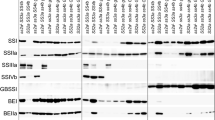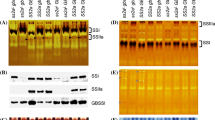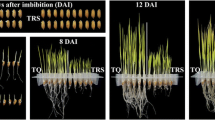Abstract
Keymessage
Biphasic starch granules in maize ae mutant underwent the weak to strong SBEIIb-defective effect during endosperm development, leading to no birefringence in their exterior due to extended long branch-chains of amylopectin.
Abstract
Biphasic starch granules are usually detected regionally in cereal endosperm lacking starch branching enzyme (SBE). However, their molecular structure, formation mechanism, and regional distribution are unclear. In this research, biphasic starch granules were observed in the inner region of crown endosperm of maize ae mutant, and had poorly oriented structure with comb-like profiles in their exterior. The inner endosperm (IE) rich in biphasic starch granules and outer endosperm (OE) without biphasic starch granules were investigated. The starch had lower amylose content and higher proportion of long branch-chains of amylopectin in IE than in OE, and the exterior of biphasic starch granules had less amylose and more long branch-chains of amylopectin than the interior. Compared with OE, the expression pattern of starch synthesis related enzymes changed significantly in IE. The granule-bound starch synthase I activity within biphasic starch granules decreased slightly. The IE experienced more severe hypoxic stress than OE, and the up-regulated anaerobic respiration pathway indicated an increase in carbon consumption. The starch in IE underwent the SBEIIb-defective effect from weak to strong due to the lack of sufficient carbon inflow, leading to the formation of biphasic starch granules and their regional distribution in endosperm. The results provided information for understanding the biphasic starch granules.








Similar content being viewed by others
References
Blazek J, Gilbert EP (2011) Application of small-angle X-ray and neutron scattering techniques to the characterisation of starch structure: a review. Carbohydr Polym 85:281–293
Blennow A, Hansen M, Schulz A, Jørgensen K, Donald AM, Sanderson J (2003) The molecular deposition of transgenically modified starch in the starch granule as imaged by functional microscopy. J Struct Biol 143:229–241
Cai C, Huang J, Zhao L, Liu Q, Zhang C, Wei C (2014a) Heterogeneous structure and spatial distribution in endosperm of high-amylose rice starch granules with different morphologies. J Agric Food Chem 62:10143–10152
Cai C, Zhao L, Huang J, Chen Y, Wei C (2014b) Morphology, structure and gelatinization properties of heterogeneous starch granules from high-amylose maize. Carbohydr Polym 102:606–614
Carciofi M, Blennow A, Jensen SL, Shaik SS, Henriksen A, Buléon A, Holm PB, Hebelstrup KH (2012) Concerted suppression of all starch branching enzyme genes in barley produces amylose-only starch granules. BMC Plant Biol 12:223
Chen J, Zeng B, Zhang M, Xie S, Wang G, Hauck A, Lai J (2014) Dynamic transcriptome landscape of maize embryo and endosperm development. Plant Physiol 166:252–264
Dong X, Zhang D, Liu J, Liu QQ, Liu H, Tian L, Jiang L, Qu LQ (2015) Plastidial disproportionating enzyme participates in starch synthesis in rice endosperm by transferring maltooligosyl groups from amylose and amylopectin to amylopectin. Plant Physiol 169:2496–2512
Evans A, McNish N, Thompson DB (2003) Polarization colors of lightly iodine-stained maize starches for amylose-extender and related genotypes in the W64A inbred line. Starch 55:250–257
Fujita N, Hasegawa H, Taira T (2001) The isolation and characterization of a waxy mutant of diploid wheat (Triticum monococcum L.). Plant Sci 160:595–602
Gayral M, Elmorjani K, Dalgalarrondo M, Balzergue SM, Pateyron S, Morel MH, Brunet S, Linossier L, Delluc C, Bakan B, Marion D (2017) Responses to hypoxia and endoplasmic reticulum stress discriminate the development of vitreous and floury endosperms of conventional maize (Zea mays) inbred lines. Front Plant Sci 8:557
Gérard C, Colonna P, Bouchet B, Gallant DJ, Planchot V (2001) A multi-stages biosynthetic pathway in starch granules revealed by the ultrastructure of maize mutant starches. J Cereal Sci 34:61–71
Goren A, Ashlock D, Tetlow IJ (2018) Starch formation inside plastids of higher plants. Protoplasma 255:1855–1876
Guo X, Ronhovde K, Yuan L, Yao B, Soundararajan MP, Elthon T, Zhang C, Holding DR (2012) Pyrophosphate-dependent fructose-6-phosphate 1-phosphotransferase induction and attenuation of Hsp gene expression during endosperm modification in quality protein maize. Plant Physiol 158:917–929
He W, Ling L, Wang J, Zhang L, Liu Q, Wei C (2018) Inhibition of starch branching enzymes in waxy rice increases the proportion of long branch-chains of amylopectin resulting in the comb-like profiles of starch granules. Plant Sci 277:177–187
Hunt HV, Denyer K, Packman LC, Jones MK, Howe CJ (2010) Molecular basis of the waxy endosperm starch phenotype in broomcorn millet (Panicum miliaceum L.). Mol Biol Evol 27:1478–1494
Jiang H, Horner HT, Pepper TM, Blanco M, Campbell M, Jane JL (2010a) Formation of elongated starch granules in high-amylose maize. Carbohydr Polym 80:533–538
Jiang H, Lio J, Blanco M, Campbell M, Jane JL (2010b) Resistant-starch formation in high-amylose maize starch during kernel development. J Agric Food Chem 58:8043–8047
Kim KS, Hwang HG, Kang HJ, Hwang IK, Lee YT, Choi HC (2005) Ultrastructure of individual and compound starch granules in isolation preparation from a high-quality, low-amylose rice, ilpumbyeo, and its mutant, G2, a high-dietary fiber, high-amylose rice. J Agric Food Chem 53:8745–8751
Kuipers AGJ, Jacobsen E, Visser RGF (1994) Formation and deposition of amylose in the potato tuber starch granule are affected by the reduction of granule-bound starch synthase gene expression. Plant Cell 6:43–52
Lappe RR, Baier JW, Boehlein SK, Huffman R, Lin Q, Wattebled F, Settles AM, Hannah LC, Borisjuk L, Rolletschek H, Stewart JD, Scott MP, Hennen-Bierwagen TA, Myers AM (2017) Functions of maize genes encoding pyruvate phosphate dikinase in developing endosperm. Proc Natl Acad Sci USA 115:E24–E33
Leroux BM, Goodyke AJ, Schumacher KI, Abbott CP, Clore AM, Yadegari R, Larkins BA, Dannenhoffer JM (2014) Maize early endosperm growth and development: from fertilization through cell type differentiation. Am J Bot 101:1259–1274
Li H, Gilbert RG (2018) Starch molecular structure: the basis for an improved understanding of cooked rice texture. Carbohydr Polym 195:9–17
Li L, Jiang H, Campbell M, Blanco M, Jane JL (2008) Characterization of maize amylose-extender (ae) mutant starches. Part I: Relationship between resistant starch contents and molecular structures. Carbohydr Polym 74:396–404
Lin L, Guo D, Huang J, Zhang X, Zhang L, Wei C (2016a) Molecular structure and enzymatic hydrolysis properties of starches from high-amylose maize inbred lines and their hybrids. Food Hydrocoll 58:246–254
Lin L, Guo D, Zhao L, Zhang X, Wang J, Zhang F, Wei C (2016b) Comparative structure of starches from high-amylose maize inbred lines and their hybrids. Food Hydrocoll 52:19–28
Liu D, Parker ML, Wellner N, Kirby AR, Cross K, Morris VJ, Cheng F (2013) Structural variability between starch granules in wild type and in ae high-amylose mutant maize kernels. Carbohydr Polym 97:458–468
Liu D, Wellner N, Parker ML, Morris VJ, Cheng F (2015) In situ mapping of the effect of additional mutations on starch granule structure in amylose-extender (ae) maize kernels. Carbohydr Polym 118:199–208
Liu F, Ahmed Z, Lee EA, Donner E, Liu Q, Ahmed R, Morell MK, Emes MJ, Tetlow LJ (2012) Allelic variants of the amylose extender mutation of maize demonstrate phenotypic variation in starch structure resulting from modified protein–protein interactions. J Exp Bot 63:1167–1183
Man J, Lin L, Wang Z, Wang Y, Liu Q, Wei C (2014) Different structures of heterogeneous starch granules from high-amylose rice. J Agric Food Chem 62:11254–11263
Man J, Yang Y, Huang J, Zhang C, Chen Y, Wang Y, Gu M, Liu Q, Wei C (2013) Effect of simultaneous inhibition of starch branching enzymes I and IIb on the crystalline structure of rice starches with different amylose contents. J Agric Food Chem 61:9930–9937
Pérez S, Bertoft E (2010) The molecular structures of starch components and their contribution to the architecture of starch granules: a comprehensive review. Starch 62:389–420
Prioul JL, Méchin V, Lessard P, Thévenot C, Grimmer M, Chateau-Joubert S, Coates S, Hartings H, Kloiber-Maitz M, Murigneux A, Sarda X, Damerval C, Edwards KJ (2008) A joint transcriptomic, proteomic and metabolic analysis of maize endosperm development and starch filling. Plant Biotechnol J 6:855–869
Regina A, Bird A, Topping D, Bowden S, Freeman J, Barsby T, Kosar-Hashemi B, Li Z, Rahman S, Morell M (2006) High-amylose wheat generated by RNA interference improves indices of large-bowel health in rats. Proc Natl Acad Sci USA 103:3546–3551
Rolletschek H, Koch K, Wobus U, Borisjuk L (2005) Positional cues for the starch/lipid balance in maize kernels and resource partitioning to the embryo. Plant J 42:69–83
Satoh H, Shibahara K, Tokunaga T, Nishi A, Tasaki M, Hwang SK, Okita TW, Kaneko N, Fujita N, Yoshida M, Hosaka Y, Sato A, Utsum Y, Ohdan T, Nakamura Y (2008) Mutation of the plastidial α-glucan phosphorylase gene in rice affects the synthesis and structure of starch in the endosperm. Plant Cell 20:1833–1849
Tuncel A, Corbin KR, Ahn-Jarvis J, Harris S, Hawkins E, Smedley MA, Harwood W, Warren FJ, Patron NJ, Smith AM (2019) Cas9-mediated mutagenesis of potato starch-branching enzymes generates a range of tuber starch phenotypes. Plant Biotechnol J 17:2259–2271
Wang J, Hu P, Lin L, Chen Z, Liu Q, Wei C (2018) Gradually decreasing starch branching enzyme expression is responsible for the formation of heterogeneous starch granules. Plant Physiol 176:582–595
Wang YJ, White P, Pollak L, Jane J (1993) Characterization of starch structures of 17 maize endosperm mutant genotypes with Oh43 inbred line background. Cereal Chem 70:171–179
Wei C, Qin F, Zhou W, Chen Y, Xu B, Wang Y, Gu M, Liu Q (2010a) Formation of semi-compound C-type starch granule in high-amylose rice developed by antisense RNA inhibition of starch-branching enzyme. J Agric Food Chem 58:11097–11104
Wei C, Qin F, Zhu L, Zhou W, Chen Y, Wang Y, Gu M, Liu Q (2010b) Microstructure and ultrastructure of high-amylose rice resistant starch granules modified by antisense RNA inhibition of starch branching enzyme. J Agric Food Chem 58:1224–1232
Wellner N, Georget DMR, Parker ML, Morris VJ (2011) In situ Raman microscopy of starch granule structures in wild type and ae mutant maize kernels. Starch 63:128–138
Yu X, Li B, Wang L, Chen X, Wang W, Wang Z, Xiong F (2015) Systematic analysis of pericarp starch accumulation and degradation during wheat caryopsis development. PLoS ONE 10:e0138228
Zhang Z, Zheng X, Yang J, Messing J, Wu Y (2016) Maize endosperm-specific transcription factors O2 and PBF network the regulation of protein and starch synthesis. Proc Natl Acad Sci USA 113:10842–19847
Zhao L, Pan T, Cai C, Wang J, Wei C (2016) Application of whole sections of mature cereal seeds to visualize the morphology of endosperm cell and starch and the distribution of storage protein. J Cereal Sci 71:19–27
Zhao L, Pan T, Guo D, Wei C (2018a) A simple and rapid method for preparing the whole section of starchy seed to investigate the morphology and distribution of starch in different regions of seed. Plant Methods 14:16
Zhao L, Xu A, Zhang L, Yin Z, Wei C (2018b) Spatiotemporal accumulation and characteristics of starch in developing maize caryopses. Plant Physiol Biochem 130:493–500
Zhou H, Wang L, Liu G, Meng X, Jing Y, Shu X, Kong X, Sun J, Yu H, Smith SM, Wu D, Li J (2016) Critical roles of soluble starch synthase SSIIIa and granule-bound starch synthase Waxy in synthesizing resistant starch in rice. Proc Natl Acad Sci USA 113:12844–12849
Zhu L, Gu M, Meng X, Cheung SCK, Yu H, Huang J, Sun Y, Shi Y, Liu Q (2012) High-amylose rice improves indices of animal health in normal and diabetic rats. Plant Biotechnol J 10:353–362
Acknowledgements
This study was financially supported by grants from the National Key Research and Development Program of China (2016YFD0101002), the National Natural Science Foundation of China (31200611), the Talent Project of Yangzhou University, and the Priority Academic Program Development of Jiangsu Higher Education Institutions.
Author information
Authors and Affiliations
Contributions
CW, DH and WH planned and designed the research. WH and XL planted and collected the samples. WH, XL, LL and AX performed experiments under the supervision of CW and DH. WH and CW analyzed data and wrote the manuscript. All authors approved the final version of the manuscript for publication.
Corresponding author
Ethics declarations
Conflict of interest
The authors declare that they have no conflict of interest.
Additional information
Publisher's Note
Springer Nature remains neutral with regard to jurisdictional claims in published maps and institutional affiliations.
Electronic supplementary material
Below is the link to the electronic supplementary material.
Rights and permissions
About this article
Cite this article
He, W., Liu, X., Lin, L. et al. The defective effect of starch branching enzyme IIb from weak to strong induces the formation of biphasic starch granules in amylose-extender maize endosperm. Plant Mol Biol 103, 355–371 (2020). https://doi.org/10.1007/s11103-020-00998-w
Received:
Accepted:
Published:
Issue Date:
DOI: https://doi.org/10.1007/s11103-020-00998-w




